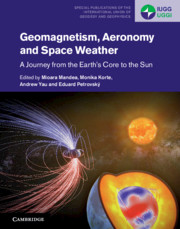Book contents
- Geomagnetism, Aeronomy and Space Weather
- Special Publications of the International Union of Geodesy and Geophysics Series
- Geomagnetism, Aeronomy and Space Weather
- Copyright page
- Contents
- Contributors
- Preface
- Part I Introduction
- Part II Geomagnetic Field
- Part III Spatial and Temporal Variations of the Geomagnetic Field
- Part IV Space Weather
- Part V Magnetic Fields beyond the Earth and beyond Today
- 17 Magnetic Field Evolution in Terrestrial Bodies from Planetesimals to Exoplanets
- 18 Solar Variability
- 19 Long- and Short-Term Geomagnetic Prediction
- Index
- References
17 - Magnetic Field Evolution in Terrestrial Bodies from Planetesimals to Exoplanets
from Part V - Magnetic Fields beyond the Earth and beyond Today
Published online by Cambridge University Press: 25 October 2019
- Geomagnetism, Aeronomy and Space Weather
- Special Publications of the International Union of Geodesy and Geophysics Series
- Geomagnetism, Aeronomy and Space Weather
- Copyright page
- Contents
- Contributors
- Preface
- Part I Introduction
- Part II Geomagnetic Field
- Part III Spatial and Temporal Variations of the Geomagnetic Field
- Part IV Space Weather
- Part V Magnetic Fields beyond the Earth and beyond Today
- 17 Magnetic Field Evolution in Terrestrial Bodies from Planetesimals to Exoplanets
- 18 Solar Variability
- 19 Long- and Short-Term Geomagnetic Prediction
- Index
- References
Summary
Space missions have shown that most terrestrial bodies have an internally generated magnetic field in their metallic core and/or a crustal field due to remanent magnetism. The latter indicates the presence of an old dynamo at the time of crust formation. Information on the two together helps to uncover the body’s magnetic field history, and it is generally accepted that convection flows driven by thermal or compositional buoyancy in the cores are the most likely source for maintaining global planetary magnetic fields. The convection flow in the core, in turn, is closely related to the interior dynamics of the mantles above and the thermal evolution of the body. This chapter describes the mechanisms for dynamo generation either by thermal or compositional convection in the core. It discusses the magnetic field evolution of Mercury, Moon, Mars, Ganymede, and planetesimals and will also address the possibility of dynamo generation in rocky exoplanets
- Type
- Chapter
- Information
- Geomagnetism, Aeronomy and Space WeatherA Journey from the Earth's Core to the Sun, pp. 267 - 285Publisher: Cambridge University PressPrint publication year: 2019
References
- 2
- Cited by



